Comprehensive Review of Alternative Proteins in Pet Food: Research Publications, Patents, and Product Trends in Plant, Aquatic, Insect, and Cell-Based Sources
Abstract
1. Introduction
2. Methodology
3. Recent Trends in Publications, Product Launches, and Patents
3.1. Plant or Pulse Crop-Based Proteins
3.2. Aquatic Plant Protein Sources
3.3. Insect-Based Proteins
4. Alternative Protein Sources in Pet Food
4.1. Plant or Crop-Based Proteins
4.2. Aquatic Plant Protein Sources
| Protein Source | Food Process | Product | Factors of Investigation | Method of Investigation | Major Finding | References |
|---|---|---|---|---|---|---|
| Macroalgae (Ulva rigida, Fucus vesiculosus), Microalga (Chlorella vulgaris) | Spray-dried mixed algae were added to commercial extruded dog food for medium-sized adult animals | Algal diet mixed into kibble for dogs | Diets: 0% (A0), 0.5% (A0.5), 1% (A1), and 1.5% (A1.5) algal blends |
|
| [10] |
| Spirulina (Arthrospira Platensis) | Tablet for for cats and dogs | Spirulina dosages: 0.4 g (cats/small dogs), 0.8 g (medium dogs), 1.2 g (large dogs) |
|
| [33] | |
| Microalgae (Chlorella vulgaris, Nannochloropis oceanica, and Tetradesmus obliquus) | Powder for dogs | Algae were added to the reference diet at 0.5–1.5% |
|
| [31] | |
| Microalgae (Tetradesmusobliquus, Chlorella vulgaris, and Nannochloropsis oceanic) | Spray dryer | Powder for dogs | - |
|
| [39] |
| Algae (Ascophyllum Nodosum) | Prepared by manufacturer | Powder for dogs |
| Metabolomic profiling data (100–1100 Da) |
| [37] |
| Microalgae species (C. vulgaris, A. platensis, H. pluvialis, and P. tricornutum) | Prepared by Micoperi Blue Growth (Ravenna, Italy) | Algal pet supplements |
|
| [32] | |
| Seaweed (Kappaphycus alvarezii, Gracilaria salicornia) | Powder for dogs | Basal diet with: Control; K. alvarezii (1.5%, 3%); G. salicornia (1.5%, 3%) |
|
| [35] | |
| Brown seaweed (Ascophyllum nodosum) with and without B. subtilis | - | Powder for dogs | Control, HP, HP+Algae (HPA), HP+Algae+B. subtilis (HPAB) |
|
| [36] |
| Brown algae (Ascophyllum nodosum, Undaria pinnatifida, and saccharina japonica) Red algae (Palmaria palmata) | Freeze dried | Powder for adult dogs | Control diet: poultry protein, grains, fats, fish meal, linseed oil, eggs, minerals; with 15 g/kg algal powder supplement |
|
| [40] |
| Brown algae (Ascophyllum nodosum L) (AN) | Powder for dogs | Control diet (CTR) and CTR supplemented with 0.3% and 1% A. nodosum powder |
|
| [41] | |
| Spirulina(Arthrospira platensis) | Spray dryer | Powder for dogs | Control diet (29% protein, 36% carbohydrate, 19% fat, 1.4% fiber) and Control + 0.2% spirulina |
|
| [34] |
| Seaweed (Kappaphycus alvarezii) | Fermentation dried seaweed | Powder in capsules for cats | Control diet, Control + 2% fermented seaweed |
|
| [38] |
| Seaweed (Laminaria spp.) combined with Saccharomyces boulardii | Enzymolysis | Powder for Ragdoll kittens | Control, Seaweed-Enzymolysis (SE), and S. boulardii (SB) |
|
| [42] |
4.3. Insect Alternative Protein in Pet Foods
| Protein Source | Food Process | Product | Factors of Investigation | Method of Investigation | Major Finding | Ref |
|---|---|---|---|---|---|---|
| Fish meal (FM), Meat and bone meal (MBM), Corn gluten meal (CGM), Soybean meal (SBM), Mealworm meal (MM), Yeast extract (YE) | - | Dry dog food with 30% ingredient replacement | Digestibility, energy, and fecal analysis | Beagle feeding trial: digestibility, energy, and fecal assessment |
| [44] |
| Black-soldier-fly larvae | Dry extruded | Dry extruded foods for cats | Pet-food digestibility, fecal and microbial analysis, fermentation, and blood profiles | Digestibility (fecal analysis), fermentation, and comprehensive blood analysis |
| [43] |
| House cricket and Mulberry silkworm pupae | Dry | Semi-moist | Fecal microbial diversity and composition | A 29-day feeding trial, including fecal sample, 16S rRNA analysis |
| [45] |
| Black-soldier-fly larvae protein and fat | Extrusion | Dry foods for dogs | Digestibility, microbial fermentation, and metabolic markers | Fecal (digestibility, SCFAs, BCFAs, microbiota) and serum (biochemistry, antioxidant, inflammatory) analysis |
| [49] |
| Black-soldier-fly larvae meal and Fermented oats | Pelletized, dried at 70 °C, then frozen (−20 °C) for storage | Pelleted food for senior dogs | Nutritional intake, digestive function, skin integrity, and immune parameters | Fecal scoring, blood parameters (CBC, biochemical, cytokines, IgG), and skin hydration/lipid profiles |
| [48] |
| Black-soldier-fly larvae meal | Extrusion (107 °C, 30 bar, 1 min), then dried (120 °C, 30 min) | Dry extruded food for dogs | Nutrient digestibility and fecal quality assessment | Beagle fecal digestibility: poultry and BSFL meal (moisture, consistency, DM) |
| [50] |
| Black-soldier-fly larvae meal | Dry extruded food for dogs | Nutrient digestibility (Crude protein, Fat, Fiber, Organic matter, Calcium, Phosphorus) | Digestibility trial: 6 dogs, TFC/marker/enzymatic methods, in vivo/in vitro correlation |
| [46] | |
| Black-soldier-fly larvae (BSFL) | Extrusion | Kibble at 30% dry matter (DM) | Digestibility and fecal parameters | Beagle diet study: BSFL vs. PM, digestibility and fecal analysis |
| [50] |
| Black-soldier-fly (BSFL) protein derivatives | - | Pet-food formulation (protein meal, hydrolysates) | Antioxidant and immunomodulatory properties | BSFL protein evaluation: nutritional, antioxidant, and immunomodulatory properties |
| [47] |
| Mushroom and Mealworm | - | Grounded dog-food attractant | Enzymatic hydrolysis and palatability characterization | Hydrolysis optimization, aroma analysis, and canine palatability testing |
| [51] |
| Black-soldier-fly larvae (BSFL), Housefly larvae (HF), Yellow mealworm (YMW) | Cryopreserved (−20 °C) and 1.25 mm sieved larvae | Freeze-dried insect-based protein for dog food | Digestibility, microbial fermentability, and metabolite analysis | A 48 h dog fecal fermentation; gas production and 1H NMR metabolite analysis |
| [52] |
4.4. Cell-Based Sources
5. Patents Relating to Alternative Proteins for Pet Foods
| Protein Source | Food Process | Product or Target Application | Major Claim | Patent Types | Country | Patent Name | Ref |
|---|---|---|---|---|---|---|---|
| Pea protein, Animal muscle-derived protein, Egg protein |
|
|
| Invention Patent | United States (US) | Meat-like Pet-food Chunks | [57] |
| Soy protein, Wheat gluten, Corn gluten, Fish meat, Livestock, Meat, Dairy proteins, Egg proteins |
|
|
| Invention Patent | Japan (JP) | Pet Food | [58] |
| Soybeans, Wheat, Rice, Barley, Rye, Red beans, Chicken, Beef, Duck, Pork, Anchovy, Pollock, Mackerel |
|
|
| Invention Patent | South Korea (KR) | Pet Feed Composition Comprising Achyranthes Japonica Nakai Extract | [59] |
| Textured soy protein, Pea, Wheat, King oyster, Mushroom, Egg yolk, Animal by-products | Extrusion | Pet snacks |
| Invention Patent | China (CN) | High-Protein Dog Snack, Cat Snack, and Preparation Method Thereof | [60] |
| Pea protein, Low-fat yogurt, Powdered chicken breast, Lean beef, Salmon, Bass, Crayfish | Microencapsulation technology | Functional pet food |
| Invention Patent | China (CN) | Formula and Preparation Method of Pet Food with Blood Sugar and Blood Fat Reducing Function | Shanghai Liangrun [61] |
| Fish, Aquatic mammals, Crustaceans, Mollusks | Enzymatic hydrolysis | Ingredient |
| Invention Patent | United States (US) | Use of natural antioxidants during enzymatic hydrolysis of aquatic protein to obtain high quality aquatic protein hydrolysates | [62] |
| Single-cell protein, Hydrolyzed protein, Protein concentrates, Peptides | Microbial fermentation Protein extracts, hydrolysates, and peptides | Meat alternatives |
| Invention Patent | South Korea (KR) | High Protein Food Composition | [63] |
| Pea protein, Soy protein, Wheat gluten, Chicken, Beef, Fish protein, Meat by-products | Extrusion | Ingredient |
| Invention Patent | United States (US) | Pet-Food Product | [64] |
| Salmon, Sardines, Mussels, Chicken, Duck |
| Ingredient |
| Invention Patent | China (CN) | Formula and Preparation Method of Fresh Meat Food for Pets | [65] |
| Chlorella, DHA, EPA, Aloe, Spirulina, Bamboo leaf, Green tea extract, Licorice root, Mulberry leaf, Meat powder | Extrusion |
|
| Invention Patent | South Korea (KR) | Feed of Dog with Chlorella and Manufacturing Method Thereof | [66] |
| Microalgae (Porphyridium cruentum), Animal blood plasma | Extrusion |
|
| Invention Patent | Europe | Pet-Food Product Comprising Microalgae as Binder | [67] |
| Water-soluble insect protein hydrolysate | Hydrolysis |
|
| Invention Patent | Netherlands (NL) | Hydrolysate of Water-Soluble Insect Proteins | [68] |
6. Challenges and Future Opportunities
7. Conclusions
Author Contributions
Funding
Institutional Review Board Statement
Informed Consent Statement
Data Availability Statement
Acknowledgments
Conflicts of Interest
References
- Tiffany, S.; Parr, J.M.; Templeman, J.; Shoveller, A.K.; Manjos, R.; Yu, A.; Verbrugghe, A. Assessment of dog owners’ knowledge relating to the diagnosis and treatment of canine food allergies. Can. Vet. J. 2019, 60, 268. [Google Scholar] [PubMed]
- Biel, W.; Natonek-Wisniewska, M.; Kepinska-Pacelik, J.; Kazimierska, K.; Czerniawska-Piatkowska, E.; Krzyscin, P. Detection of chicken DNA in commercial dog foods. BMC Vet. Res. 2022, 18, 92. [Google Scholar] [CrossRef] [PubMed]
- Robinson, G.H.J.; Balk, J.; Domoney, C. Improving pulse crops as a source of protein, starch and micronutrients. Nutr. Bull. 2019, 44, 202–215. [Google Scholar] [CrossRef] [PubMed]
- Pali-Scholl, I.; De Lucia, M.; Jackson, H.; Janda, J.; Mueller, R.S.; Jensen-Jarolim, E. Comparing immediate-type food allergy in humans and companion animals-revealing unmet needs. Allergy 2017, 72, 1643–1656. [Google Scholar] [CrossRef] [PubMed]
- Mueller, R.S.; Olivry, T.; Prelaud, P. Critically appraised topic on adverse food reactions of companion animals (2): Common food allergen sources in dogs and cats. BMC Vet. Res. 2016, 12, 9. [Google Scholar] [CrossRef] [PubMed]
- Durdakova, M.; Kolackova, M.; Ridoskova, A.; Cernei, N.; Pavelicova, K.; Urbis, P.; Richtera, L.; Pelcova, P.; Adam, V.; Huska, D. Exploring the potential nutritional benefits of Arthrospira maxima and Chlorella vulgaris: A focus on vitamin B12, amino acids, and micronutrients. Food Chem. 2024, 452, 139434. [Google Scholar] [CrossRef] [PubMed]
- Makkar, H.P.S.; Tran, G.; Heuzé, V.; Ankers, P. State-of-the-art on use of insects as animal feed. Anim. Feed Sci. Technol. 2014, 197, 1–33. [Google Scholar] [CrossRef]
- Govorushko, S. Global status of insects as food and feed source: A review. Trends Food Sci. Technol. 2019, 91, 436–445. [Google Scholar] [CrossRef]
- Kara, K.; Kahraman, O.; İnal, F.; İnanç, Z.S.; Yilmaz Öztaş, S.; Alataş, M.S.; Ahmed, I. Digestion, faeces microbiome, and selected blood parameters in dogs fed extruded food containing Black soldier fly (Hermetia illucens) meal. Ital. J. Anim. Sci. 2025, 24, 466–483. [Google Scholar] [CrossRef]
- Mota, C.S.; Cabrita, A.R.; Yergaliyev, T.; Camarinha-Silva, A.; Almeida, A.; Abreu, H.; Silva, J.; Fonseca, A.J.; Maia, M.R.G. Macroalgae and microalga blend in dogs’ food: Effects on palatability, digestibility, and fecal metabolites and microbiota. Algal Res. 2024, 84, 103775. [Google Scholar] [CrossRef]
- Matassa, S.; Boon, N.; Pikaar, I.; Verstraete, W. Microbial protein: Future sustainable food supply route with low environmental footprint. Microb. Biotechnol. 2016, 9, 568–575. [Google Scholar] [CrossRef] [PubMed]
- Gahukar, R.T. Edible Insects Farming: Efficiency and Impact on Family Livelihood, Food Security, and Environment Compared With Livestock and Crops. In Insects as Sustainable Food Ingredients; Elsevier: Amsterdam, The Netherlands, 2016; pp. 85–111. [Google Scholar]
- Failla, M.; Hopfer, H.; Wee, J. Evaluation of public submissions to the USDA for labeling of cell-cultured meat in the United States. Front. Nutr. 2023, 10, 1197111. [Google Scholar] [CrossRef] [PubMed]
- Webb, D.; Dogan, H.; Li, Y.; Alavi, S. Physico-Chemical Properties and Texturization of Pea, Wheat and Soy Proteins Using Extrusion and Their Application in Plant-Based Meat. Foods 2023, 12, 1586. [Google Scholar] [CrossRef] [PubMed]
- Lidzba, N.; Garcia Arteaga, V.; Schiermeyer, A.; Havenith, H.; Muranyi, I.; Schillberg, S.; Lehmann, J.; Ueberham, E. Development of Monoclonal Antibodies against Pea Globulins for Multiplex Assays Targeting Legume Proteins. J. Agric. Food Chem. 2021, 69, 2864–2874. [Google Scholar] [CrossRef] [PubMed]
- Yang, J.; Zamani, S.; Liang, L.; Chen, L. Extraction methods significantly impact pea protein composition, structure and gelling properties. Food Hydrocoll. 2021, 117, 106678. [Google Scholar] [CrossRef]
- Miranda, C.G.; Rodrigues, R.M.; Pereira, R.N.; Speranza, P.; Kurozawa, L.E.; Vicente, A.A.; Sato, A.C.K. Influence of ohmic heating on lentil protein structure and protein-pectin interactions. Innov. Food Sci. Emerg. Technol. 2023, 87, 103413. [Google Scholar] [CrossRef]
- Johansson, M.; Johansson, D.; Ström, A.; Rydén, J.; Nilsson, K.; Karlsson, J.; Moriana, R.; Langton, M. Effect of starch and fibre on faba bean protein gel characteristics. Food Hydrocoll. 2022, 131, 107741. [Google Scholar] [CrossRef]
- Nagarajan, D.; Varjani, S.; Lee, D.-J.; Chang, J.-S. Sustainable aquaculture and animal feed from microalgae—Nutritive value and techno-functional components. Renew. Sustain. Energy Rev. 2021, 150, 111549. [Google Scholar] [CrossRef]
- Sharma, B.; Yadav, D.K.; Malakar, S.; Singh, S.; Sharma, M.; Suri, S.; Sridhar, K. Insect proteins—Production technologies, bio-functional, and food applications: A perspective. Food Biosci. 2024, 61, 104560. [Google Scholar] [CrossRef]
- Akhtar, Y.; Isman, M.B. Insects as an Alternative Protein Source. In Proteins in Food Processing; Woodhead Publishing: Cambridge, UK, 2018; pp. 263–288. [Google Scholar]
- Kipkoech, C. Beyond proteins—Edible insects as a source of dietary fiber. Polysaccharides 2023, 4, 116–128. [Google Scholar] [CrossRef]
- Jacuńska, W.; Biel, W.; Zych, K. Evaluation of the Nutritional Value of Insect-Based Complete Pet Foods. Appl. Sci. 2024, 14, 10258. [Google Scholar] [CrossRef]
- Acuff, H.L.; Dainton, A.N.; Dhakal, J.; Kiprotich, S.; Aldrich, G. Sustainability and Pet Food: Is There a Role for Veterinarians? Vet. Clin. N. Am. Small Anim. Pract. 2021, 51, 563–581. [Google Scholar] [CrossRef] [PubMed]
- Knight, A. The relative benefits for environmental sustainability of vegan diets for dogs, cats and people. PLoS ONE 2023, 18, e0291791. [Google Scholar] [CrossRef] [PubMed]
- Krintiras, G.A.; Göbel, J.; Jan van der Goot, A.; Stefanidis, G.D. Stefanidis. Production of structured soy-based meat analogues using simple shear and heat in a Couette Cell. J. Food Eng. 2015, 160, 34–41. [Google Scholar] [CrossRef]
- Sha, L.; Xiong, Y.L. Plant protein-based alternatives of reconstructed meat: Science, technology, and challenges. Trends Food Sci. Technol. 2020, 102, 51–61. [Google Scholar] [CrossRef]
- Wehrmaker, A.M.; Bosch, G.; van der Goot, A.J. Effect of sterilization and storage on a model meat analogue pet food. Anim. Feed Sci. Technol. 2021, 271, 114737. [Google Scholar] [CrossRef]
- Wehrmaker, A.M.; Zenker, H.E.; de Groot, W.; Sanders, M.; van der Goot, A.J.; Janssen, A.E.M.; Keppler, J.; Bosch, G. Amino Acid Modifications During the Production (Shearing, Sterilization) of Plant-Based Meat Analogues: An Explorative Study Using Pet Food Production as an Example. ACS Food Sci. Technol. 2022, 2, 1753–1765. [Google Scholar] [CrossRef]
- Wehrmaker, A.M.; de Groot, W.; Jan van der Goot, A.; Keppler, J.K.; Bosch, G. In vitro digestibility and solubility of phosphorus of three plant-based meat analogues. J. Anim. Physiol. Anim. Nutr. 2024, 108 (Suppl. 1), 24–35. [Google Scholar] [CrossRef] [PubMed]
- Cabrita, A.R.; Guilherme-Fernandes, J.; Spínola, M.; Maia, M.R.; Yergaliyev, T.; Camarinha-Silva, A.; Fonseca, A.J. Effects of microalgae as dietary supplement on palatability, digestibility, fecal metabolites, and microbiota in healthy dogs. Front. Vet. Sci. 2023, 10, 1245790. [Google Scholar] [CrossRef] [PubMed]
- Dalmonte, T.; Vecchiato, C.G.; Biagi, G.; Fabbri, M.; Andreani, G.; Isani, G. Iron Bioaccessibility and Speciation in Microalgae Used as a Dog Nutrition Supplement. Vet. Sci. 2023, 10, 138. [Google Scholar] [CrossRef] [PubMed]
- Stefanutti, D.; Tonin, G.; Morelli, G.; Zampieri, R.M.; La Rocca, N.; Ricci, R. Oral palatability and owners’ perception of the effect of increasing amounts of Spirulina (Arthrospira platensis) in the diet of a cohort of healthy dogs and cats. Animals 2023, 13, 1275. [Google Scholar] [CrossRef] [PubMed]
- Satyaraj, E.; Reynolds, A.; Engler, R.; Labuda, J.; Sun, P. Supplementation of diets with spirulina influences immune and gut function in dogs. Front. Nutr. 2021, 8, 667072. [Google Scholar] [CrossRef] [PubMed]
- Srinivas, K.Y.; Das, A.; Reddy, P.B.; Verma, A.K. Supplementation of tropical red seaweeds improved gut health indices, antioxidant status and immunity in adult dogs. J. Appl. Phycol. 2024, 36, 2183–2198. [Google Scholar] [CrossRef]
- Isidori, M.; Rueca, F.; Massacci, F.R.; Diaferia, M.; Giontella, A.; Caldin, M.; Furlanello, T.; Corbee, R.J.; Mannucci, G.; Pezzotti, G.; et al. The use of Ascophyllum nodosum and Bacillus subtilis C-3102 in the management of canine chronic inflammatory enteropathy. A Pilot study. Anim. 2021, 11, 3417. [Google Scholar] [CrossRef] [PubMed]
- Gawor, J.P.; Wilczak, J.; Svensson, U.K.; Jank, M. Influence of Dietary Supplementation with a Powder Containing AN ProDen™ (Ascophyllum nodosum) Algae on Dog Saliva Metabolome. Front. Vet. Sci. 2021, 8, 681951. [Google Scholar] [CrossRef] [PubMed]
- Mohamad Yusof, L.; Ahmad, H.; Hassim, H.A.; Mustaffa-Kamal, F.; Omar, S.; Zainundin, N.K.; Padam, B.S. A study on the impact of diet supplementation of fermented dried seaweed powder (Kappaphycus alvarezii) on healthy cat gut performance, skin and hair coat conditions, and behaviour. Vet. Res. Commun. 2024, 48, 3061–3072. [Google Scholar] [CrossRef] [PubMed]
- Cabrita, A.R.; Guilherme-Fernandes, J.; Valente, I.M.; Almeida, A.; Lima, S.A.; Fonseca, A.J.; Maia, M.R. Nutritional composition and untargeted metabolomics reveal the potential of Tetradesmus obliquus, Chlorella vulgaris and Nannochloropsis oceanica as valuable nutrient sources for dogs. Animals 2022, 12, 2643. [Google Scholar] [CrossRef] [PubMed]
- Pinna, C.; Vecchiato, C.G.; Grandi, M.; Stefanelli, C.; Zannoni, A.; Biagi, G. Seaweed supplementation failed to affect fecal microbiota and metabolome as well as fecal IgA and apparent nutrient digestibility in adult dogs. Animals 2021, 11, 2234. [Google Scholar] [CrossRef] [PubMed]
- Isidori, M.; Rueca, F.; Trabalza-Marinucci, M. Palatability of extruded dog diets supplemented with Ascophyllum nodosum L. (Fucaceae, Phaeophyceae). J. Appl. Phycol. 2019, 31, 3275–3281. [Google Scholar] [CrossRef]
- Zhang, M.; Mo, R.; Li, M.; Qu, Y.; Wang, H.; Liu, T.; Liu, P.; Wu, Y. Comparison of the effects of enzymolysis seaweed powder and Saccharomyces boulardii on intestinal health and microbiota composition in kittens. Metabolites 2023, 13, 637. [Google Scholar] [CrossRef] [PubMed]
- Bosch, G.; Loureiro, B.; Schokker, D.; Kar, S.; Paul, A.; Sluczanowski, N. Black soldier fly larvae meal in an extruded food: Effects on nutritional quality and health parameters in healthy adult cats. J. Insects Food Feed 2024, 10, 1595–1606. [Google Scholar] [CrossRef]
- Zhang, Q.; Sun, H.; Gao, Z.; Zhao, H.; Peng, Z.; Zhang, T. Evaluation of Effective Energy Values of Six Protein Ingredients Fed to Beagles and Predictive Energy Equations for Protein Feedstuff. Animals 2024, 14, 1599. [Google Scholar] [CrossRef] [PubMed]
- Areerat, S.; Chundang, P.; Lekcharoensuk, C.; Patumcharoenpol, P.; Kovitvadhi, A. Insect-based diets (house crickets and mulberry silkworm pupae): A comparison of their effects on canine gut microbiota. Vet. World 2023, 16, 1627. [Google Scholar] [CrossRef] [PubMed]
- Penazzi, L.; Schiavone, A.; Russo, N.; Nery, J.; Valle, E.; Madrid, J.; Martinez, S.; Hernandez, F.; Pagani, E.; Ala, U. In vivo and in vitro digestibility of an extruded complete dog food containing black soldier fly (Hermetia illucens) larvae meal as protein source. Front. Vet. Sci. 2021, 8, 653411. [Google Scholar] [CrossRef] [PubMed]
- Mouithys-Mickalad, A.; Schmitt, E.; Dalim, M.; Franck, T.; Tome, N.M.; van Spankeren, M.; Serteyn, D.; Paul, A. Black soldier fly (Hermetia illucens) larvae protein derivatives: Potential to promote animal health. Animals 2020, 10, 941. [Google Scholar] [CrossRef] [PubMed]
- Seo, K.; Cho, H.-W.; Chun, J.; Jeon, J.; Kim, C.; Kim, M.; Park, K.; Kim, K. Evaluation of fermented oat and black soldier fly larva as food ingredients in senior dog diets. Animals 2021, 11, 3509. [Google Scholar] [CrossRef] [PubMed]
- Jian, S.; Zhang, L.; Ding, N.; Yang, K.; Xin, Z.; Hu, M.; Zhou, Z.; Zhao, Z.; Deng, B.; Deng, J. Effects of black soldier fly larvae as protein or fat sources on apparent nutrient digestibility, fecal microbiota, and metabolic profiles in beagle dogs. Front. Microbiol. 2022, 13, 1044986. [Google Scholar] [CrossRef] [PubMed]
- Abd El-Wahab, A.; Meyer, L.; Kölln, M.; Chuppava, B.; Wilke, V.; Visscher, C.; Kamphues, J. Insect larvae meal (Hermetia illucens) as a sustainable protein source of canine food and its impacts on nutrient digestibility and fecal quality. Animals 2021, 11, 2525. [Google Scholar] [CrossRef] [PubMed]
- Feng, T.; Hu, Z.; Tong, Y.; Yao, L.; Zhuang, H.; Zhu, X.; Song, S.; Lu, J. Preparation and evaluation of mushroom (Lentinus edodes) and mealworm (Tenebrio molitor) as dog food attractant. Heliyon 2020, 6, e05302. [Google Scholar] [CrossRef] [PubMed]
- Bosch, G.; Vervoort, J.; Hendriks, W. In vitro digestibility and fermentability of selected insects for dog foods. Anim. Feed Sci. Technol. 2016, 221, 174–184. [Google Scholar] [CrossRef]
- Stefanutti, D. A new protein source for pet food: Cultivated meat. Companion Anim. 2024, 29, 146–150. [Google Scholar] [CrossRef]
- Oven, A.; Yoxon, B.; Milburn, J. Investigating the market for cultivated meat as pet food: A survey analysis. PLoS ONE 2022, 17, e0275009. [Google Scholar] [CrossRef] [PubMed]
- Andy, C. Eat Just Eyes Cultivated-Meat Scale-Up After New Singapore Nod, in Just Food; Verdict Media Limited: London, UK, 2023. [Google Scholar]
- Zafalon, R.V.A.; Risolia, L.W.; Vendramini, T.H.A.; Rodrigues, R.B.A.; Pedrinelli, V.; Teixeira, F.A.; Brunetto, M.A. Nutritional inadequacies in commercial vegan foods for dogs and cats. PLoS ONE 2020, 15, e0227046. [Google Scholar] [CrossRef] [PubMed]
- Ray, T.K. Meat-like pet food chunks. US Patent 20200229460A1, 19 March 2020. [Google Scholar]
- Miyamoto, K. Pet food. JP Patent 6502042B2. filed 29 August 2014, and issused 17 April 2019.60.
- Hwang, K.T. Pet feed composition comprising Achyranthes japonica Nakai extract. KR Patent 20230120275A, 17 August 2023. [Google Scholar]
- Qingda Yalute Food Co., Ltd. High-Protein Dog Snack, Cat Snack, and Preparation Method Thereof. CN Patent 111642648B, 12 April 2022. [Google Scholar]
- Gao, H. Formula and preparation method of pet food with blood sugar and blood fat reducing function. CN Patent 118000356A, 10 May 2024. [Google Scholar]
- Halldorsdottir, S.M.; Kristinsson, H.G.; Jonsdottir, R. Use of natural antioxidants during enzymatic hydrolysis of aquatic protein to obtain high-quality aquatic protein hydrolysates. US Patent 20150274791A1, 1 October 2015. [Google Scholar]
- Air Protein Inc. High-protein food composition. KR Patent 20220123019A, 5 September 2022.
- Mars Inc. Pet food product. US Patent 12096781B2, 24 September 2024. [Google Scholar]
- Shanghai Peitong Technology Co., Ltd. Formula and preparation method of fresh meat food for pets. CN Patent 116491600A, 28 July 2023. [Google Scholar]
- Daesang Farmsco Co., Ltd., Feed of dog with Chlorella and manufacturing method thereof. KR Patent 100865779B1, 28 October 2008.
- Mars; Incorporated. Pet food product comprising microalgae as binder. EP Patent 3562319B1, 13 November 2024. [Google Scholar]
- Netherlands Patent Office. Hydrolysate of water-soluble insect proteins. NL Patent 2027744B1, 16 September 2022. [Google Scholar]
- Precup, G.; Ververis, E.; Azzollini, D.; Rivero-Pino, F.; Zakidou, P.; Germini, A. The safety assessment of insects and products thereof as novel foods in the European Union. In Novel Foods and Edible Insects in the European Union; Springer: Cham, Switzerland, 2022; pp. 123–146. [Google Scholar]
- Lee, J.H.; Kim, T.K.; Cha, J.Y.; Jang, H.W.; Yong, H.I.; Choi, Y.S. How to develop strategies to use insects as animal feed: Digestibility, functionality, safety, and regulation. J. Anim. Sci. Technol. 2022, 64, 409. [Google Scholar] [CrossRef] [PubMed]
- Ni, D. Allergenic potential of insect proteins: Cross-reactivity, detection, degradation, and implications for food safety and labelling. Food Sci. Anim. Prod. 2025, 3, 9240127. [Google Scholar] [CrossRef]
- Premrov Bajuk, B.; Zrimšek, P.; Kotnik, T.; Leonardi, A.; Križaj, I.; Jakovac Strajn, B. Insect protein-based diet as potential risk of allergy in dogs. Animals 2021, 11, 1942. [Google Scholar] [CrossRef] [PubMed]
- Van der Fels-Klerx, H.J.; Camenzuli, L.; Belluco, S.; Meijer, N.; Ricci, A. Food safety issues related to uses of insects for feeds and foods. Compr. Rev. Food Sci. Food Saf. 2018, 17, 1172–1183. [Google Scholar] [CrossRef] [PubMed]
- Johnson, H.; Monaco, A. Global developments in the regulation of cultivated meat: A comparative study of the EU, Singapore, US and Australia and New Zealand. Rev. Eur. Comp. Int. Environ. Law. 2025. [Google Scholar] [CrossRef]
- Garrison, G.L.; Biermacher, J.T.; Brorsen, B.W. How much will large-scale production of cell-cultured meat cost? J. Agric. Food Res. 2022, 10, 100358. [Google Scholar] [CrossRef]
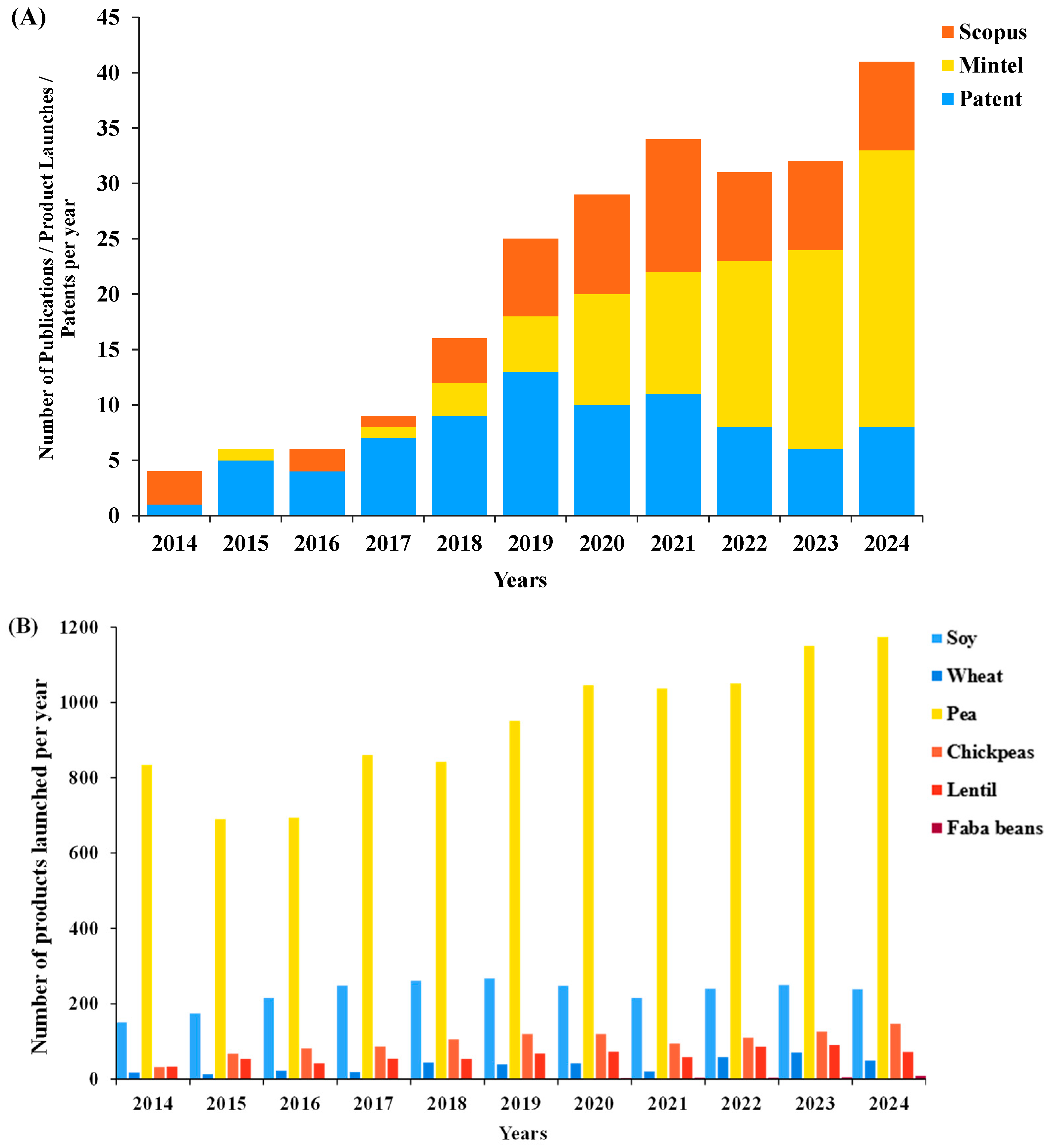
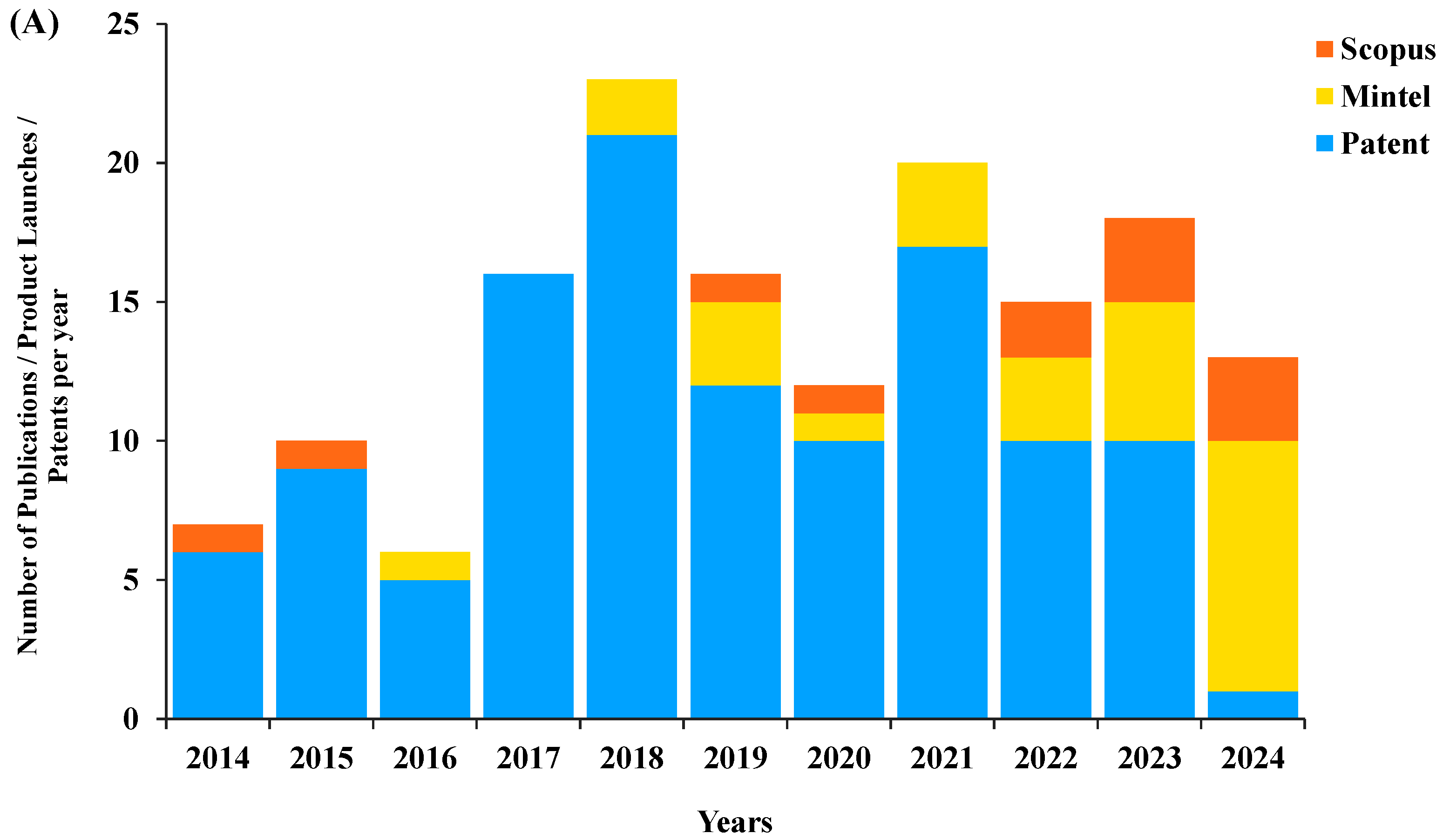
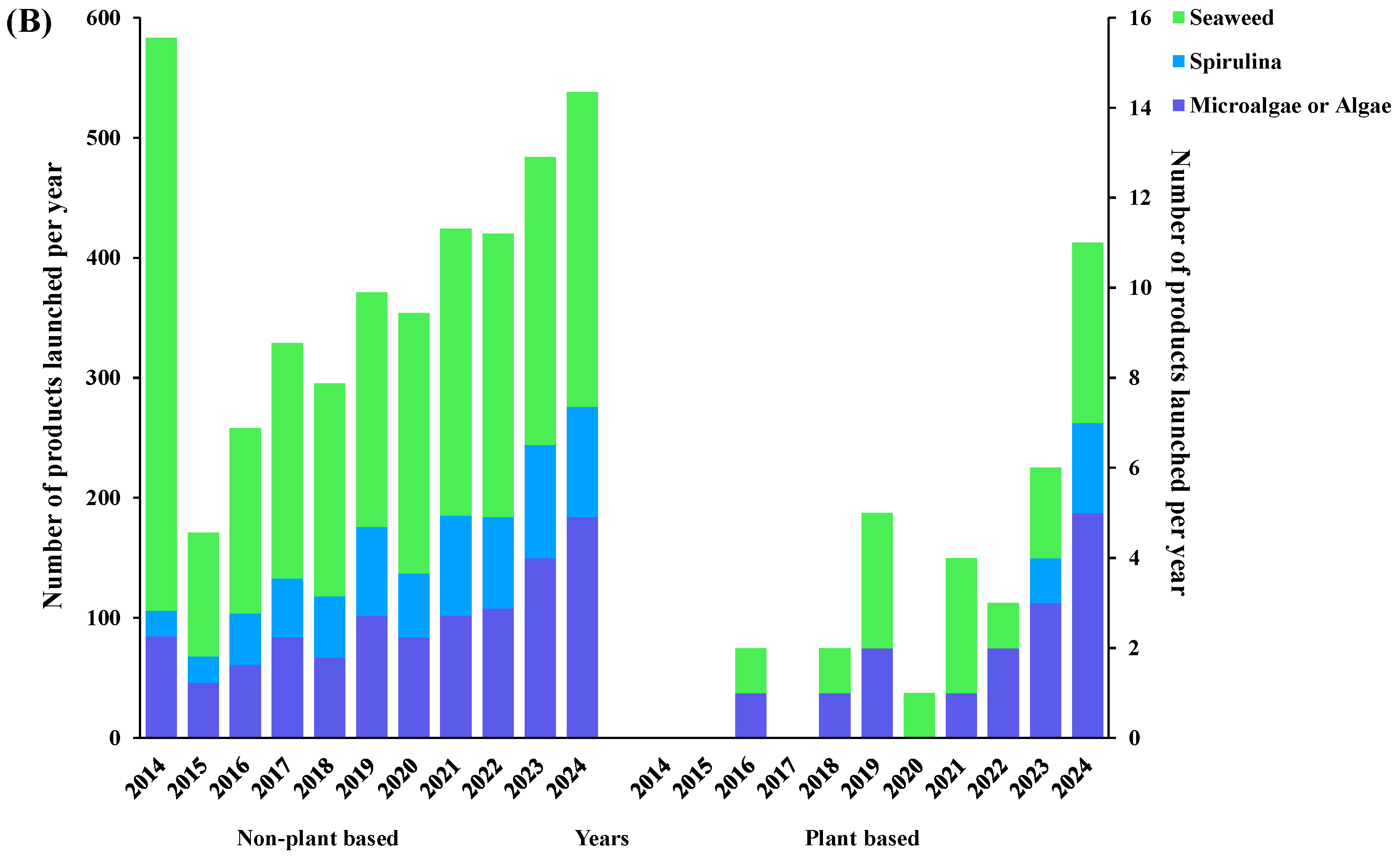
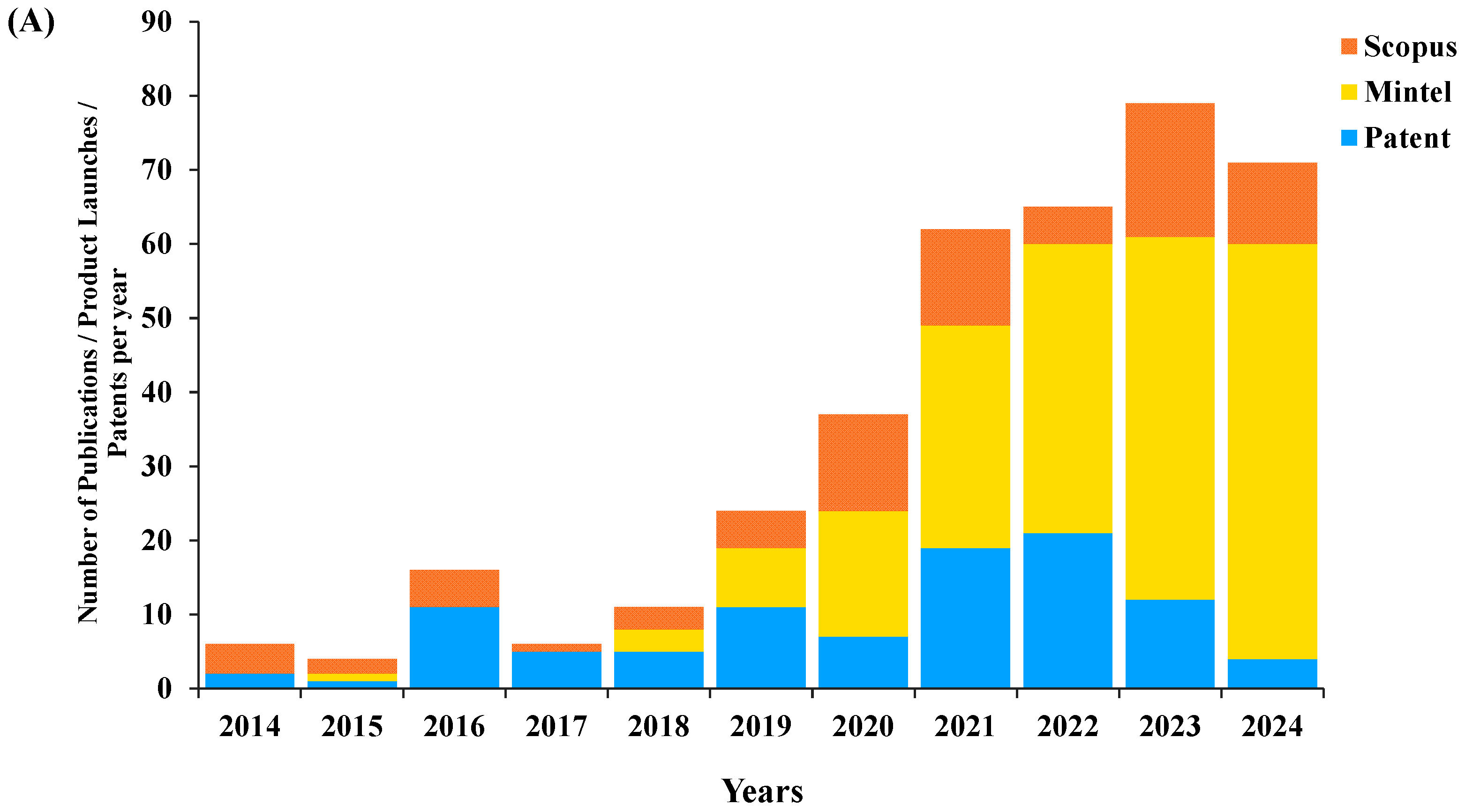
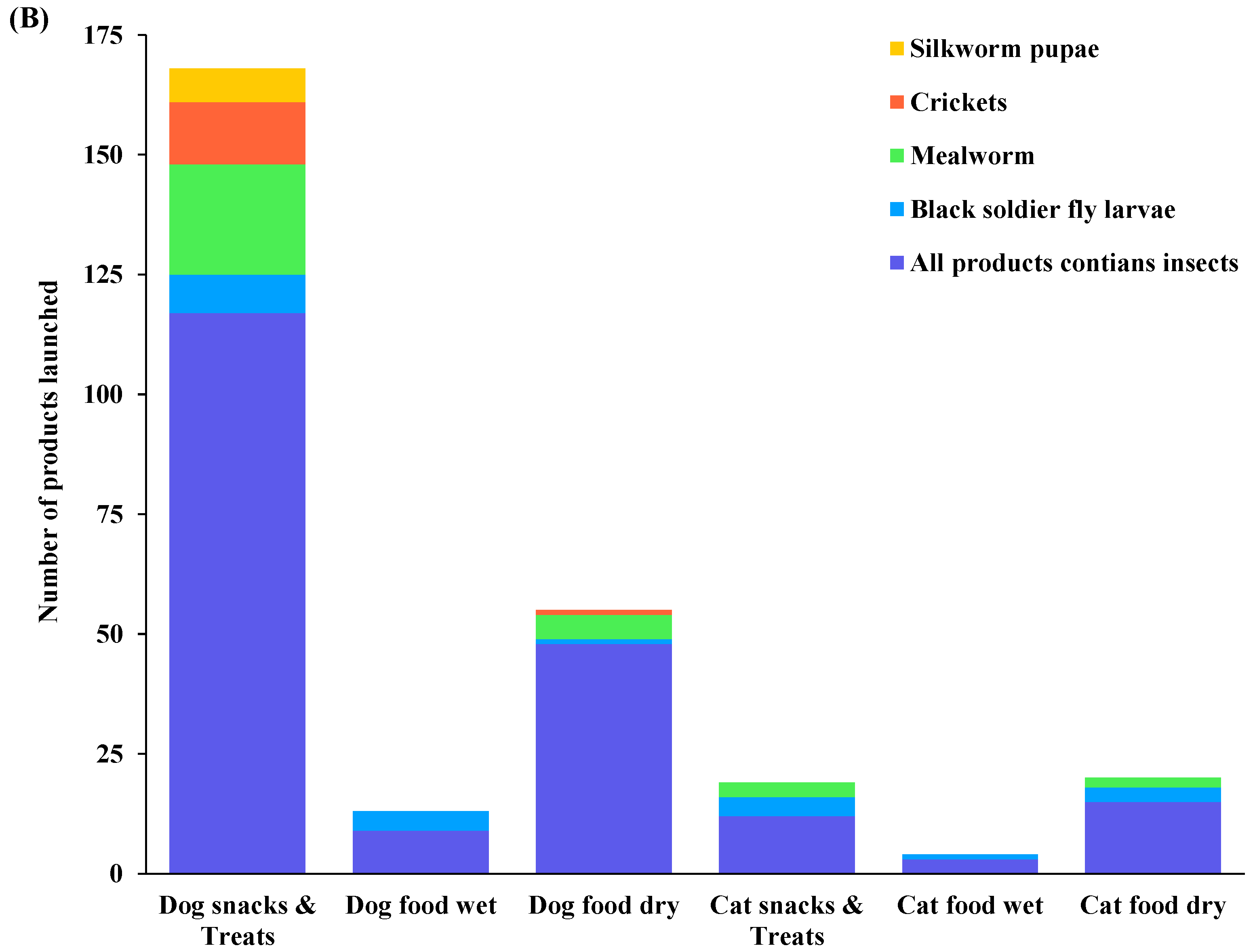
| Protein Source | Food Process | Product | Factors of Investigation | Method of Investigation | Major Finding | Ref. |
|---|---|---|---|---|---|---|
| Soy protein isolate and wheat gluten (MaSoy), pea protein isolates and wheat gluten (MaPea). | Sheared (120 °C, 30 min, 30 rpm) and sterilized (125.5 °C, 1.36 bar, 26 min) | Canned chunk meat analogue |
|
|
| [29] |
| Soy protein isolate and wheat gluten. | Sheared (120 °C, 30 min, 30 rpm), sterilized (124.5 °C, 1.28 bar, 36.6 min), and stored (21 °C, 7 or 28 days) | Couette-cell meat analogue (CCMA) |
|
|
| [28] |
| Wheat gluten and soy protein isolate (MaSoy), wheat gluten and pea protein isolate (MaPea), and wheat gluten and faba bean concentrate (MaFaba). | Sheared (120 °C, 30 min) and sterilized (126.6 °C, 21 min, 1.36 bar) | Canned chunk meat analogue in water and gravy |
|
|
| [30] |
Disclaimer/Publisher’s Note: The statements, opinions and data contained in all publications are solely those of the individual author(s) and contributor(s) and not of MDPI and/or the editor(s). MDPI and/or the editor(s) disclaim responsibility for any injury to people or property resulting from any ideas, methods, instructions or products referred to in the content. |
© 2025 by the authors. Licensee MDPI, Basel, Switzerland. This article is an open access article distributed under the terms and conditions of the Creative Commons Attribution (CC BY) license (https://creativecommons.org/licenses/by/4.0/).
Share and Cite
Klinmalai, P.; Kamonpatana, P.; Thongpech, A.; Sodsai, J.; Promhuad, K.; Srisa, A.; Laorenza, Y.; Kovitvadhi, A.; Areerat, S.; Seubsai, A.; et al. Comprehensive Review of Alternative Proteins in Pet Food: Research Publications, Patents, and Product Trends in Plant, Aquatic, Insect, and Cell-Based Sources. Foods 2025, 14, 2640. https://doi.org/10.3390/foods14152640
Klinmalai P, Kamonpatana P, Thongpech A, Sodsai J, Promhuad K, Srisa A, Laorenza Y, Kovitvadhi A, Areerat S, Seubsai A, et al. Comprehensive Review of Alternative Proteins in Pet Food: Research Publications, Patents, and Product Trends in Plant, Aquatic, Insect, and Cell-Based Sources. Foods. 2025; 14(15):2640. https://doi.org/10.3390/foods14152640
Chicago/Turabian StyleKlinmalai, Phatthranit, Pitiya Kamonpatana, Arisara Thongpech, Janenutch Sodsai, Khwanchat Promhuad, Atcharawan Srisa, Yeyen Laorenza, Attawit Kovitvadhi, Sathita Areerat, Anusorn Seubsai, and et al. 2025. "Comprehensive Review of Alternative Proteins in Pet Food: Research Publications, Patents, and Product Trends in Plant, Aquatic, Insect, and Cell-Based Sources" Foods 14, no. 15: 2640. https://doi.org/10.3390/foods14152640
APA StyleKlinmalai, P., Kamonpatana, P., Thongpech, A., Sodsai, J., Promhuad, K., Srisa, A., Laorenza, Y., Kovitvadhi, A., Areerat, S., Seubsai, A., Sablani, S. S., & Harnkarnsujarit, N. (2025). Comprehensive Review of Alternative Proteins in Pet Food: Research Publications, Patents, and Product Trends in Plant, Aquatic, Insect, and Cell-Based Sources. Foods, 14(15), 2640. https://doi.org/10.3390/foods14152640







